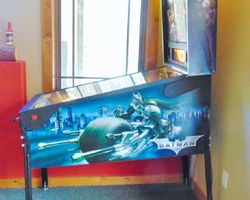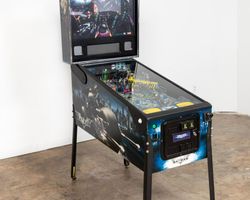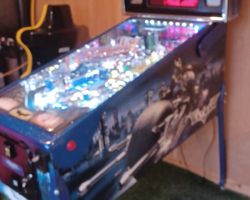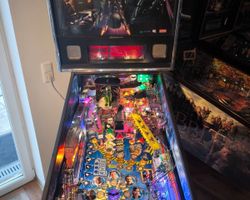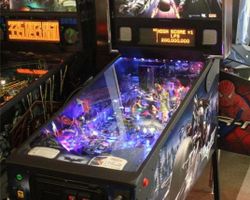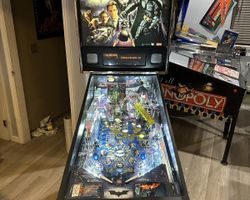Batman
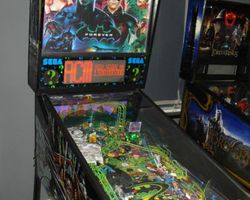
Average Prices: USD $3,100 to $6,100
Produced: July, 2008
Machine Type: Solid State Electronic
MPU: Stern S.A.M. Board System
Players: 4
Design by: George Gomez
Art by: Margaret Hudson, Kevin O'Connor
Dots/Animation by: Mark Galvez, Tom Kyzivat
Sound by: Ken Hale
Software by: Lyman F. Sheats Jr., Lonnie D. Ropp
In July 2008, Stern Pinball, Inc. released a pinball machine themed around the acclaimed film The Dark Knight, a cinematic portrayal of Batman. This machine, simply titled "Batman," drew inspiration directly from the movie's gritty aesthetic and complex narrative, aiming to immerse players in Gotham City's struggle against chaos. George Gomez, known for his ability to translate licensed properties into compelling pinball experiences, led the design effort for "Batman." He collaborated with a talented team, including artists Kevin O'Connor and Margaret Hudson, who were responsible for the game's visual identity. The software, a critical component for gameplay depth, was crafted by Lyman F. Sheats Jr., a programmer with a reputation for intricate rule sets. The auditory experience, encompassing music and sound effects, was developed by Ken Hale, with animations by Mark Galvez and Tom Kyzivat. Fred Young contributed custom voice characterizations, further enriching the thematic integration.
"Batman" was produced in a run of 3,500 units, making it a significant release for Stern at the time. Its debut MSRP was $5,999.00, placing it as a premium offering in the pinball market. The machine operated on Stern's S.A.M. Board System, a robust platform that allowed for sophisticated gameplay mechanics and a detailed Dot Matrix display. This period marked a point where Stern continued to refine its approach to licensed themes, leveraging popular culture to broaden pinball's appeal. The machine's production date was July 21, 2008, solidifying its place as a contemporary pinball experience of its era.
Distinctive Elements and Playfield Presentation
"Batman" incorporates several signature features designed to capture the essence of The Dark Knight film. Central to the playfield's interactive elements is the Joker's reveal mechanism. This unique toy consists of a rotating cylinder that, upon activation, unveils a miniature Gotham City skyline, an articulated Joker figure, and a detailed mural of the Joker's face. This mechanism serves not only as a visual spectacle but also integrates into key gameplay objectives. Another prominent feature is the Scarecrow's crane, a dynamic rotating arm that suspends a ball on a heavy spring. Players must accurately strike this swinging target to progress through Scarecrow-related objectives, adding a physical challenge to the gameplay.
The Batmobile teeter-totter mechanism offers another layer of interaction. Positioned beneath a clear Lexan ramp, a Hot Wheels Tumbler car is mounted on a seesaw that tips as the ball traverses the ramp, creating a visual race effect. These toys are not merely decorative; they are integral to the game's flow and mission structure, designed to provide distinct shot experiences and visual feedback that reinforce the thematic narrative. The game's cabinet art is particularly notable, frequently cited for its strong visual appeal and thematic cohesion, contributing significantly to the machine's overall aesthetic and presence in a collection.
Playfield Layout and Interactive Mechanics
The "Batman" playfield is structured to encourage a fast-paced game with a clear flow. The layout features two main flippers and a single ramp, which plays a crucial role in diverting the ball. This ramp can send the ball to either the Batmobile Bridge, with its distinctive teeter-totter, or to an elevated mini-playfield. This multi-leveled design adds verticality and complexity to the shot map. Three pop bumpers are strategically placed to keep the ball in play and generate unpredictable deflections, contributing to the game's dynamic feel.
Key shot objectives include a drop target that guards access to the Joker lock, essential for initiating the Joker multiball. A captive ball provides another target for skill shots and point accumulation. The playfield is adorned with artwork by Kevin O'Connor and Margaret Hudson, depicting scenes and characters from the movie, though some players note that the playfield art can appear dark or busy. Despite this, the overall lighting scheme is designed to enhance the atmospheric quality, guiding the player's eye to active shots and highlighting progress through various modes. The design philosophy aimed to blend direct, repeatable shots with more intricate, skill-based challenges associated with the unique toys, striving for player immersion within the Batman universe.
Dynamic Gameplay and Strategic Depth
"Batman" features a deep rule set, characteristic of Lyman F. Sheats Jr.'s software design, offering a progression system that appeals to players seeking extended engagement. The game includes both 2-ball and 4-ball multiball modes, which are central to achieving high scores and advancing through the game's narrative. Players embark on various missions and objectives tied to the film's antagonists, notably the Joker and Scarecrow.
A primary objective involves initiating the Joker multiball, which often requires hitting the drop target to access the lock, followed by precise shots to ignite the frenzy. The Scarecrow’s Crane mechanism is another focal point for gameplay, requiring players to time shots to hit the suspended ball and defeat the villain, a feature often cited as a highlight due to its unique physical interaction. While some early versions of the game's software and certain toys like the Batmobile teeter-totter drew criticism for perceived lack of integration or repetitiveness, subsequent software updates, particularly up to version 2.94, significantly refined the gameplay, deepening the rules and improving overall flow. These updates addressed initial feedback, enhancing the challenge and replayability, and ensuring that the various modes and scoring opportunities felt more intuitive and rewarding for dedicated players.
Community Reception and Enduring Appeal
Upon its release, "Batman" garnered a mixed but generally positive reception within the pinball community. Its strengths were frequently highlighted: a fast, fluid gameplay experience with smooth shots and a good sense of flow. Many players appreciated the deep rule set and the variety of missions, which provided substantial long-term engagement. The multiball modes, especially the Joker multiball, were often praised for their excitement and contribution to high-scoring opportunities. The integration of the Dark Knight theme was widely regarded as successful, with the cabinet artwork drawing particular commendation for its visual impact.
The Scarecrow Crane stood out as a universally celebrated feature, often cited as one of the most engaging and innovative toys in modern pinball, adding a unique physical challenge that players enjoyed. The game’s music was also noted for complementing the theme effectively. However, "Batman" also faced criticism. Some found the playfield artwork to be "mediocre" or "dark," lacking the vibrancy expected by some players, while others felt it appeared "photoshopped" or "cluttered." The Batmobile teeter-totter, while conceptually interesting, sometimes received feedback that it did not significantly enhance gameplay or that its action could slow the game down. The custom voice characterizations, particularly for the Joker, were polarizing, with some players finding them uninspiring or even detrimental to the immersion. Despite these points of contention, the machine has maintained a strong presence in the pinball community, often seen as a solid example of a licensed theme executed with engaging toys and a comprehensive rule set, especially with the later software revisions. Its legacy is tied to its strong thematic delivery and the interactive novelty of its signature playfield mechanisms, securing its place as a memorable Stern release.
Sponsored Links
 Ebay Listings
Ebay Listings
 Auction Results
Auction Results
| Cost | Location | Date |
|---|---|---|
| USD $4,999 |  Florida, United States Florida, United States |
22 May, 2025 |
| GBP £3,311 |  Rotherham, United Kingdom Rotherham, United Kingdom |
04 February, 2025 |
| EUR €6,100 |  Austria Austria |
16 January, 2025 |
| USD $6,000 |  Michigan, United States Michigan, United States |
07 April, 2024 |
| USD $6,395 |  Colorado, United States Colorado, United States |
18 May, 2023 |
| USD $7,700 |  Florida, United States Florida, United States |
30 April, 2023 |
| USD $6,500 |  Indiana, United States Indiana, United States |
26 May, 2022 |
| USD $7,995 |  Texas, United States Texas, United States |
08 February, 2022 |
| USD $4,000 |  Georgia, United States Georgia, United States |
23 October, 2021 |
| USD $6,250 |  Arizona, United States Arizona, United States |
09 October, 2021 |


Private Policy · Search Website · Contact Us
As an eBay Partner, we may earn a commission from qualifying purchases made through links on this site, at no additional cost to you.
All trademarks and copyrighted materials remain property of their respective owners. All other content copyright 2007 - 2025 Pinpedia.

